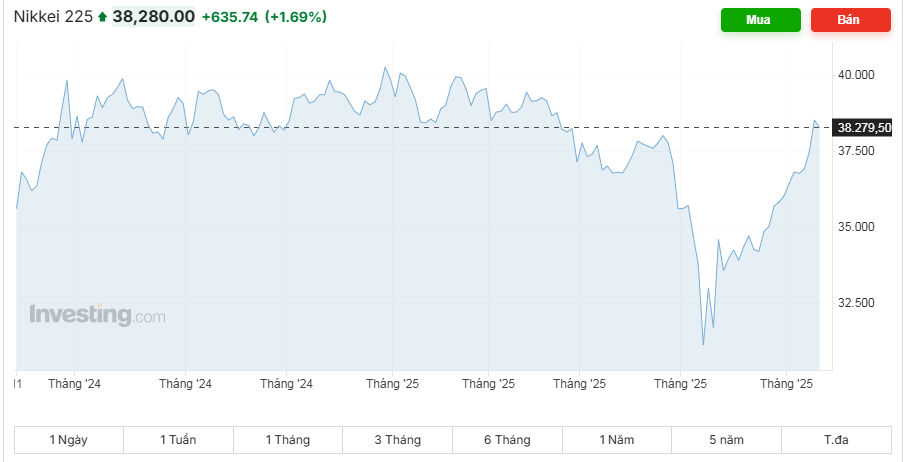 |
| Japan's Nikkei 225 index performance |
Under the interim deal, the US will cut tariffs on Chinese imports from 145% to 30% over the next three months, while China's tariffs on US imports will fall from 125% to 10%.
In addition, US Trade Representative Jamieson Greer said in an interview with Fox News that China also agreed to lift export restrictions imposed after April 2, including restrictions on rare earth minerals and magnets widely used in high-tech manufacturing.
Global financial markets have responded strongly to the pause in the trade war between the world's two largest economies, which has caused nearly $600 billion in bilateral trade to stagnate, threatening to push the global economy into recession.
Accordingly, Wall Street stocks increased sharply in the trading session on Monday (May 12), with the Dow Jones index soaring 1,160.72 points, equivalent to 2.81%, closing at 42,410.10 points; S&P 500 increased 3.26%, closing at 5,844.19 points, the highest level since March 3; Nasdaq Composite increased 4.35% and closed at 18,708.34 points, the highest level since February 28.
This excitement continued in the Asia- Pacific market in the morning trading session on Tuesday (May 13).
Specifically, Taiwan's TWII index increased by 2%; Korea's Kospi index increased by 0.17%; while in Australia, the A&P/ASX 200 index increased by 0.53%; in mainland China, the Shanghai index increased slightly by 0.06%... However, Hong Kong's Hang Sheng index decreased by 1.78%.
That sent MSCI's broadest index of Asia- Pacific shares outside Japan to a six-month high. In Japan, the Nikkei 225 also rose 1.67%, while the Topix index rose 1.24%.
“The real victory here is the change in tone from both the US and China. Words like ‘mutual respect’ and ‘dignity’ mark a dramatic shift from the recent confrontational rhetoric, and that’s what the market is cheering,” said Charu Chanana, chief investment strategist at Saxo in Singapore.
But analysts say the temporary truce in the trade war between the world's two largest economies still fails to resolve many of the underlying conflicts that led to the dispute, including the US trade deficit with China and US President Donald Trump's demands that Beijing do more to combat the US fentanyl crisis.
Even US Treasury Secretary Scott Bessent, who struck the deal Monday with his Chinese counterparts during weekend talks in Geneva, acknowledged it would take years to reset Washington’s trade relationship with Beijing.
“A cooling-off is inevitable and I think it’s clear that there won’t be much sustainable outcome from these talks,” said Christopher Hodge, chief U.S. economist at Natixis. “When all is said and done, tariffs will still be significantly higher and will weigh on U.S. growth.”
Credit rating agency Fitch estimates that the effective US tariff rate is now 13.1%, which, while down significantly from the pre-deal level of 22.8%, is still much higher than the 2.3% level at the end of 2024.
Investors' focus will now turn to the details of the deal and what happens after 90 days. But in the short term, attention will be on U.S. inflation data due later Tuesday.
“If we see another round of weak CPI numbers, this could turn traders’ attention back to Fed policy and the possibility of a cut, and dampen the dollar’s recovery,” said Matt Simpson, senior market analyst at City Index.
The shift in US-China trade relations has prompted traders to further reduce bets on a Fed rate cut, suggesting policymakers may be under less pressure to ease rates to boost growth.
Traders are now pricing in a total of 57 basis points of Fed rate cuts this year, down from more than 100 basis points at the height of tariff-induced jitters in mid-April.Source: https://thoibaonganhang.vn/chung-khoan-chau-a-khoi-sac-khi-my-trung-hoa-hoan-thuong-chien-164078.html


![[Photo] Prime Minister Pham Minh Chinh chairs meeting on science and technology development](https://vphoto.vietnam.vn/thumb/1200x675/vietnam/resource/IMAGE/2025/5/17/ae80dd74c384439789b12013c738a045)


![[Photo] Readers line up to visit the photo exhibition and receive a special publication commemorating the 135th birthday of President Ho Chi Minh at Nhan Dan Newspaper](https://vphoto.vietnam.vn/thumb/1200x675/vietnam/resource/IMAGE/2025/5/17/85b3197fc6bd43e6a9ee4db15101005b)

![[Photo] More than 17,000 candidates participate in the 2025 SPT Competency Assessment Test of Hanoi National University of Education](https://vphoto.vietnam.vn/thumb/1200x675/vietnam/resource/IMAGE/2025/5/17/e538d9a1636c407cbb211b314e6303fd)














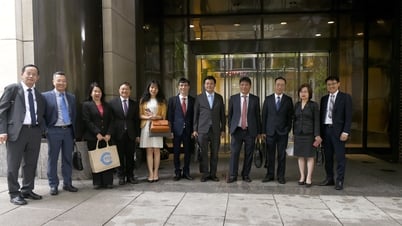
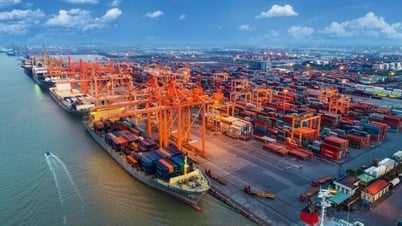
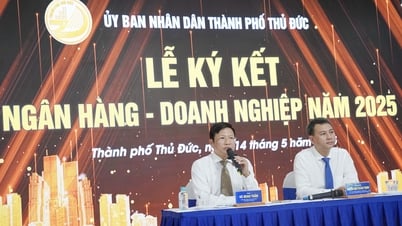
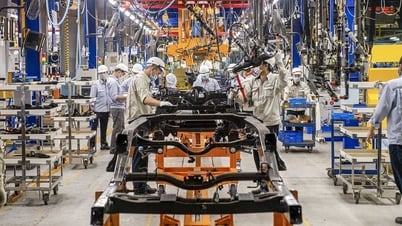
![[Photo] Nearly 3,000 students moved by stories about soldiers](https://vphoto.vietnam.vn/thumb/1200x675/vietnam/resource/IMAGE/2025/5/17/21da57c8241e42438b423eaa37215e0e)










































































Comment (0)